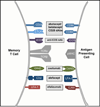Targeting co-stimulatory pathways: transplantation and autoimmunity
- PMID: 24100403
- PMCID: PMC4365450
- DOI: 10.1038/nrneph.2013.183
Targeting co-stimulatory pathways: transplantation and autoimmunity
Abstract
The myriad of co-stimulatory signals expressed, or induced, upon T-cell activation suggests that these signalling pathways shape the character and magnitude of the resulting autoreactive or alloreactive T-cell responses during autoimmunity or transplantation, respectively. Reducing pathological T-cell responses by targeting T-cell co-stimulatory pathways has met with therapeutic success in many instances, but challenges remain. In this Review, we discuss the T-cell co-stimulatory molecules that are known to have critical roles during T-cell activation, expansion, and differentiation. We also outline the functional importance of T-cell co-stimulatory molecules in transplantation, tolerance and autoimmunity, and we describe how therapeutic blockade of these pathways might be harnessed to manipulate the immune response to prevent or attenuate pathological immune responses. Ultimately, understanding the interplay between individual co-stimulatory and co-inhibitory pathways engaged during T-cell activation and differentiation will lead to rational and targeted therapeutic interventions to manipulate T-cell responses and improve clinical outcomes.
Figures



References
-
- Salomon B, Bluestone JA. Complexities of CD28/B7: CTLA-4 costimulatory pathways in autoimmunity and transplantation. Annu Rev Immunol. 2001;19:225–252. - PubMed
-
- Linsley PS, et al. Immunosuppression in vivo by a soluble form of the CTLA-4 T cell activation molecule. Science. 1992;257:792–795. - PubMed
-
- Lenschow D, et al. Long-term survival of xenogeneic pancreatic islet grafts induced by CTLA4Ig. Science. 1992;257:789–792. - PubMed
-
- Finck BK, Linsley PS, Wofsy D. Treatment of murine lupus with CTLA4Ig. Science. 1994;265:1225–1227. - PubMed
Publication types
MeSH terms
Grants and funding
LinkOut - more resources
Full Text Sources
Other Literature Sources
Medical
Miscellaneous

